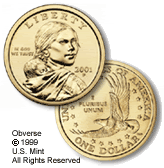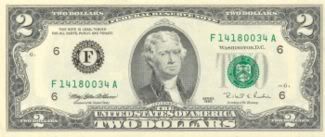The $1 note is not cost-effective to produce given it's lifespan relative to the larger notes. Furthermore, the US Treasury has issued $2 notes that have never been used in widespread circulation. Ditto for the $1 coins which should have replaced the $1 notes.
It is doubtful that very many people in the US have ever contemplated the challenges faced by the blind and vision-impaired when it comes to handling currency. Unfortunately, seeing eye dogs have not advanced that far. Things may soon change:
U.S. District Judge James Robertson on Tuesday ordered the Treasury Department to start working on the problem, leaving it up to government officials to determine the best solution. Possible changes include making bills of differing sizes or adding embossed dots or raised ink.
The government has 10 days to decide whether to appeal the ruling. The Treasury Department had no immediate comment.
The possibility of an appeal makes my blood boil. There is no logic in appealing.
Electronic devices are available to help blind people differentiate between bills, but many complain that they are slow, expensive and unreliable. Visually impaired shoppers frequently rely on store clerks to help them.
''It's just frankly unfair that blind people should have to rely on the good faith of people they have never met in knowing whether they've been given the correct change,'' said Jeffrey A. Lovitky, attorney for the blind plaintiffs in the lawsuit.
[...]
''Of the more than 180 countries that issue paper currency, only the United States prints bills that are identical in size and color in all their denominations,'' Robertson wrote. ''More than 100 of the other issuers vary their bills in size according to denomination, and every other issuer includes at least some features that help the visually impaired.''
In court documents, government attorneys said changing the way money feels would be expensive. Cost estimates ranged from $75 million in equipment upgrades and $9 million annual expenses for punching holes in bills to $178 million in one-time charges and $50 million annual expenses for printing bills of varying sizes.
Boo hoo. Pity the poor government. Why do we continue to mint pennies when the cost to stamp them out is more than they are worth?
The US mint produces about 7 billion pennies every year (roughly half of all coins made each year), at a cost of $100 million dollars. About one-third of this money is used to pay for the zinc that pennies are made out of, which is why the zinc industry is lobbying to keep the penny in production.
When I see wasteful spending it's usually not hard to find a lobbyist culprit just below the surface.
In addition to ceasing production of the penny, we need to stop printing one-dollar bills. We already have the dollar coins which are not being used, and will not be used, as long as $1 notes are still thrust on us.
Retailers wouldn't even need to redesign their tills. Elimination of the penny would make room for the dollar coins and elimination of the $1 note would allow the $2 note to replace it.

The dollar coins coupled with the $2 bill would be a wise first step for the government to take as we begin the process of making our currency more easily recognizable to all citizens.

Let's stop wasting money; call off the lawyers, forget the appeals, and move forward with a currency plan that makes sense... for once.
Crossposted at B3

No comments:
Post a Comment